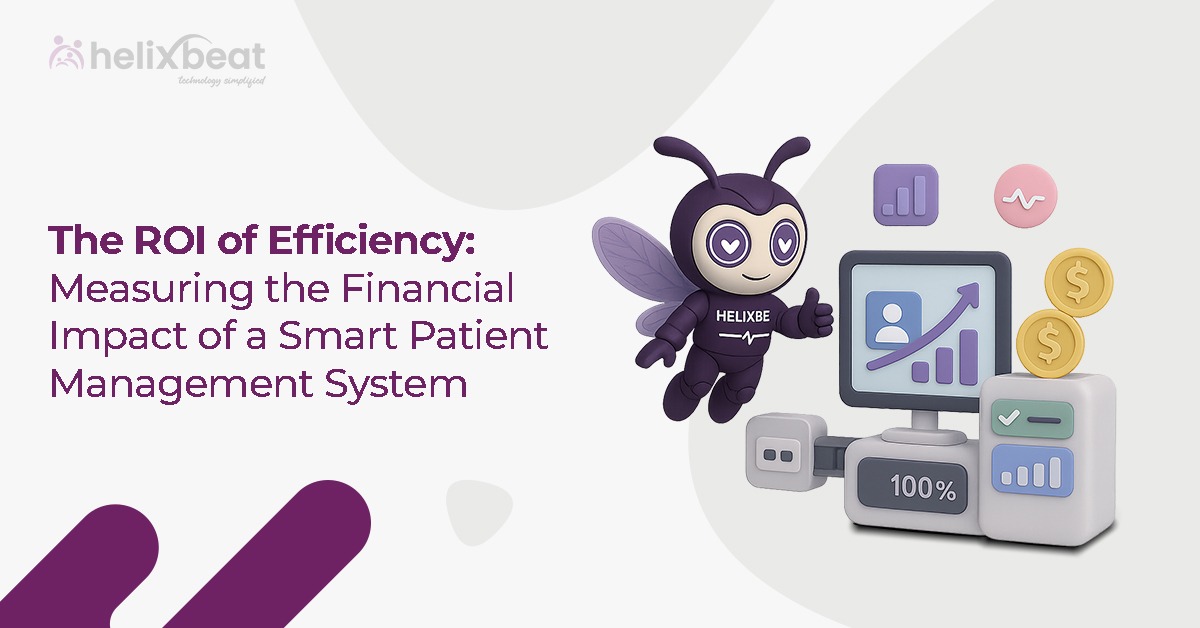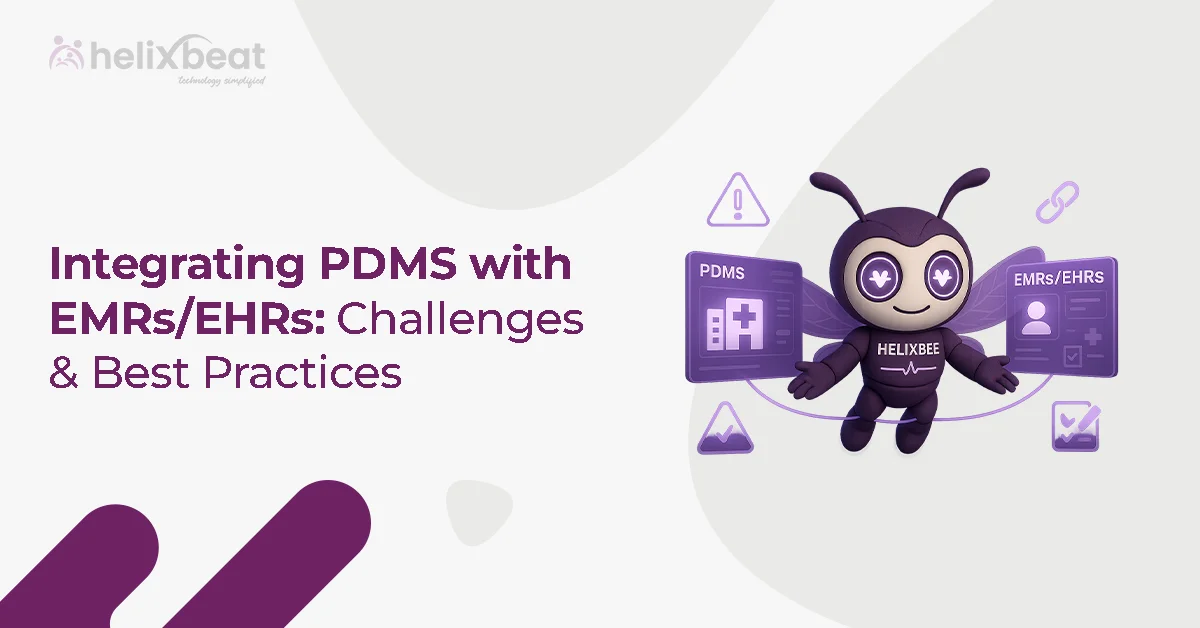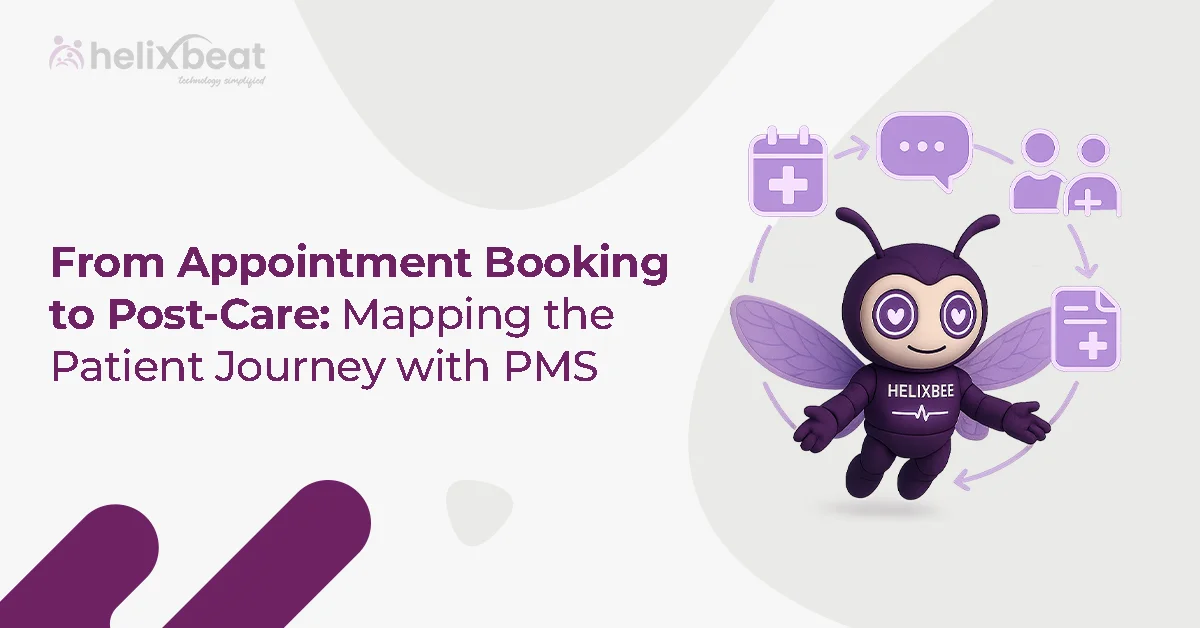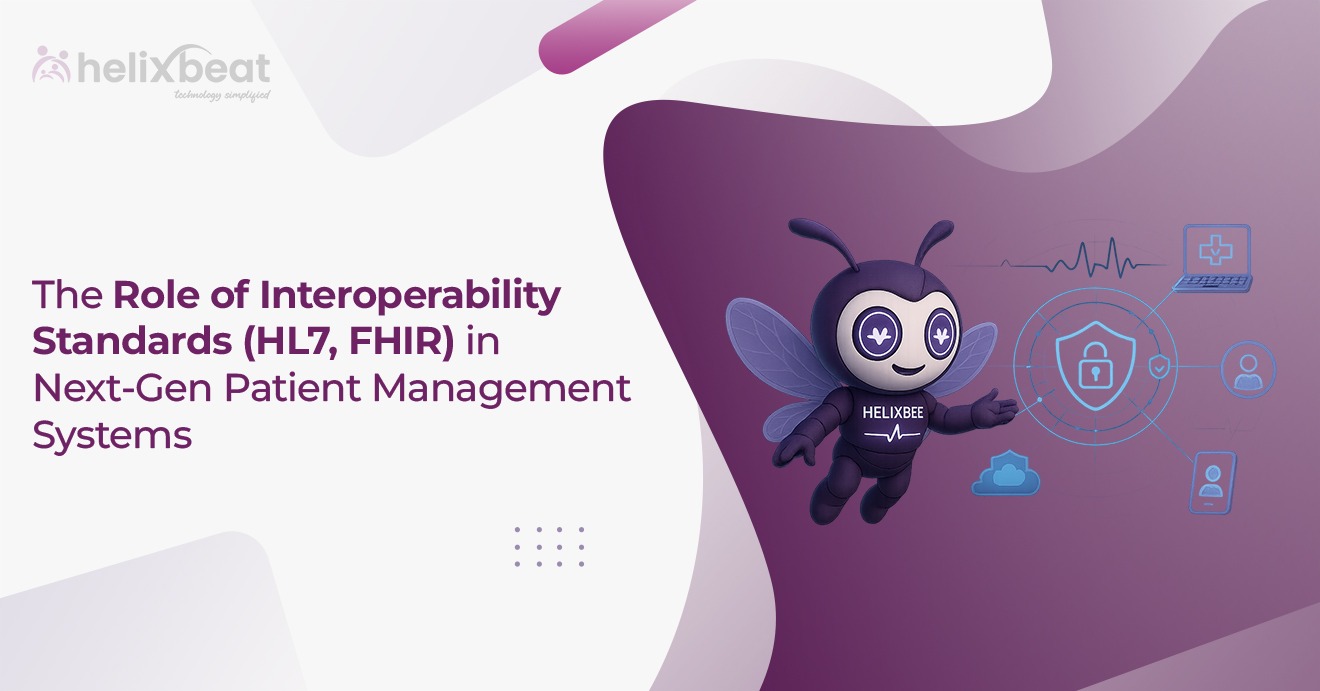In this blog, we explore how a patient management system can transform the financial landscape of your healthcare organization. By streamlining operations, improving patient care, and reducing administrative costs, a patient management system offers more than just a technological upgrade; it delivers measurable financial benefits.
From minimizing errors to improving patient satisfaction, the ROI of a smart patient management system can help you achieve significant cost savings and improved overall performance. Let’s dive into how these systems can revolutionize your operations and boost your bottom line.

Table of Contents
What is a Patient Management System?
A patient management system (PMS) is a comprehensive software solution developed to streamline and optimize various elements of healthcare management, including patient data, scheduling, billing, and overall patient care processes. This system integrates all critical healthcare functions into a single, suitable platform, enhancing efficiency and communication while reducing human errors.
Key Features of Patient Management Software
Appointment Scheduling
- This feature automates the entire appointment process, from booking to reminders, thereby reducing administrative overhead and ensuring patients attend their scheduled appointments.
- Automated reminders also lower no-show rates, which can significantly improve scheduling efficiency and reduce lost revenue for healthcare providers.
Billing and Payments
- Efficient billing and payment tracking are crucial for healthcare organizations.
- A patient management system automatically processes and tracks patient payments, billing details, and insurance claims.
- This ensures timely reimbursements and minimizes errors associated with manual billing processes, helping improve cash flow and financial stability.
Medical Record Management
- With a patient management system, all patient records are centralized, making it easier for healthcare providers to access and update patient information in real-time.
- This centralization of patient data ensures that providers have the most current and complete information at their fingertips, enhancing the quality of care and enabling faster, more informed decision-making.
Patient Communication Tools
- Communication is key in healthcare, and a PMS offers secure, reliable channels for both patient-provider and internal communication.
- Whether it’s sending appointment reminders, test results, or follow-up instructions, patient communication tools ensure that information is transmitted efficiently, securely, and without delay.
What is the ROI of Efficiency in Healthcare?
The ROI of efficiency in healthcare refers to the measurable financial and operational advantages that can be derived from improving healthcare processes. By executing automation and optimizing workflows, healthcare providers can seriously reduce time and costs, improving the overall effectiveness of their benefits. A patient management system (PMS) plays a crucial role in driving these efficiencies. Below are keyways that a PMS contributes to the ROI of healthcare organizations:
1. Reducing Organizational Costs
- One of the most significant advantages of a patient management system is its ability to automate administrative tasks such as scheduling, billing, and patient record management.
- By eliminating manual entry and reducing human error, these processes become more efficient, freeing up valuable staff time.
- Example: Automated scheduling and billing features reduce the need for administrative staff to manually enter and process patient data, resulting in lower labor costs.
2. Improving Operational Efficiency
- With real-time access to patient data, healthcare professionals can make quicker, more informed decisions.
- Patient management software ensures that patient records, medical histories, and treatment plans are always up-to-date and readily accessible, which streamlines clinical workflows and enhances the decision-making process.
- Example: PULSE by HelixBeat integrates patient data from various sources in real-time, allowing healthcare providers to make faster treatment decisions and reduce patient wait times.
3. Increasing Patient Satisfaction
- Streamlining healthcare processes, including appointment scheduling, communication, and billing, have a direct impact on the patient experience.
- By eliminating delays, improving response times, and offering easier access to services, a PMS contributes to higher patient satisfaction.
- Example: Automated reminders for appointments and follow-ups reduce patient frustration and increase engagement, leading to improved patient retention rates and greater patient loyalty.
4. Improved Resource Management
- By automating routine tasks and improving workflow coordination, a patient management system optimizes the use of both human and technological resources.
- With fewer errors and more accurate data, healthcare providers can allocate resources more effectively, ensuring that staff focus on tasks that directly impact patient care.
- Example: Reducing manual data entry and paper-based processes allows administrative staff to focus more on patient interaction and care coordination.
5. Enhanced Financial Performance
- By improving operational efficiency and reducing administrative costs, healthcare organizations can significantly enhance their financial performance.
- Greater accuracy in billing and faster claims processing lead to quicker reimbursements and fewer denials, enhancing cash flow and financial stability.
- Example: Automated billing processes ensure timely and accurate insurance claims, resulting in faster payments and fewer claim rejections, ultimately improving revenue cycles.
How Do Patient Management Systems Improve Patient Information Management?
A well-implemented patient management system offers several key benefits that improve both the patient experience and the workflow of healthcare providers:
Centralized Data
- All patient information, including medical history, appointments, test results, and treatment plans, is stored in a single, secure, and centralized location.
- This centralized system ensures that authorized personnel can access critical patient data at any time, improving decision-making and eliminating the need for manual record retrieval.
- PULSE by HelixBeat further enhances this process by integrating real-time data from wearables and remote monitoring devices, ensuring healthcare providers have the latest updates on a patient’s condition.
Reduces Errors
- Eliminates inconsistencies and outdated records that can occur with paper-based or fragmented systems.
- Automated record-keeping also streamlines administrative tasks, enabling staff to devote more time to patient care rather than paperwork.
Improves Coordination
- A patient management system enables all healthcare providers—regardless of their department or location—to access the same up-to-date patient data.
- This real-time access enhances collaboration between doctors, nurses, specialists, and administrative staff, ensuring that everyone involved in a patient’s care is on the same page.
- It also reduces redundancy by preventing the need for repeated tests or procedures, saving both time and resources.
Measuring the ROI of Patient Management Systems in Hospitals
- Cost Savings
- Clinical Outcomes
- Patient Satisfaction
- Efficiency Improvements
- Return on Investment (ROI) Metrics
How Patient Management Systems Drive Long-Term Savings?
In the long run, patient management systems offer substantial cost savings by improving efficiency and reducing overhead. Here’s how:
- Improving Efficiency
- Streamlined methods, such as appointment scheduling, patient tracking, and record-keeping, allow healthcare staff to focus on patient care, thereby further reducing labor costs.
- A patient management system enables healthcare providers to spend less time on paperwork and more time with patients.
- Enhancing Care Coordination
- By improving communication between departments, the system helps prevent errors and unnecessary treatments, reducing waste and overall healthcare spending.
- A patient management system centralizes patient data, ensuring that healthcare providers across departments have access to the latest patient information.
How to Calculate ROI in Healthcare?
Estimating the ROI in healthcare for a patient management system concern assessing the costs associated with the system’s performance and the consequent financial benefits. Here’s how to go about it:
1. Identify Investment Costs
Begin by determining the total investment required to adopt the patient management system. This includes:
- Upfront Costs: The price of purchasing the software, hardware, and any necessary equipment.
- Training Costs: The time and resources spent on training staff to use the system effectively.
- Ongoing Maintenance Costs: The annual or monthly cost of software updates, technical support, and system upkeep.
- Understanding these costs is crucial for determining how long it will take to recoup the investment and assessing the system’s impact on overall financial resources.
2. Quantify Savings and Benefits
Next, calculate the savings that result from implementing the patient management system. These benefits include:
- Increased Operational Efficiency: By automating scheduling, record-keeping, and billing, the system reduces the time staff spend on administrative tasks, allowing them to focus more on patient care. This results in labor cost savings and improves operational efficiency.
- Reduced Errors: A patient record management system eliminates the risk of manual data entry errors, thereby reducing costly mistakes in patient information, prescriptions, and billing. This leads to fewer rework costs and avoids expensive legal risks.
3. Measure the Impact on Revenue
A significant component of ROI calculation is assessing how the patient management software directly impacts revenue:
- Improved Billing and Reimbursement: A patient management system enhances accuracy in coding and billing, thereby reducing rejected claims and increasing reimbursement rates.
- Efficient Patient Tracking: With real-time tracking of patient interactions, healthcare providers can monitor unpaid bills and ensure that follow-ups are automated, improving overall financial efficiency.
- With PULSE by HelixBeat, healthcare organizations can also track real-time patient data, leading to more precise billing based on actual service usage, which improves revenue cycle management and reduces financial leakage.
In Summary
Hence, this blog demonstrates how the ROI of a patient management system is crucial for healthcare organizations seeking to streamline operations and enhance financial performance.
By considering investment costs, quantifying savings, and measuring the impact on revenue, healthcare providers can clearly understand the value these systems bring. HelixBeat’s PULSE offers a solution that not only simplifies these calculations but also ensures a seamless experience for both patients and providers. By improving billing accuracy, reducing errors, and providing real-time tracking of patient data, PULSE by HelixBeat enables healthcare organizations to maximize their ROI.
Get a Free Demo of HelixBeat’s Patient Management System
FAQs
- What is a patient management system?
A patient management system is software that helps healthcare providers manage patient information, appointments, billing, and other administrative tasks. It streamlines healthcare operations and improves patient care efficiency.
- How does a patient management system benefit healthcare organizations?
A patient management system improves efficiency by automating scheduling, billing, and patient record management. It reduces administrative workload, errors, and enhances overall patient experience.
- What is the ROI of a patient management system?
The ROI of a patient management system is measured by cost savings from reduced administrative tasks, improved revenue from accurate billing, and better patient retention, leading to long-term financial benefits.
- What features should a patient management system have?
A good patient management system should include features like patient record management, appointment scheduling, billing and payment tracking, secure patient data storage, and integration with other healthcare systems.
- How does patient data privacy relate to patient management systems?
Patient management systems help ensure patient data privacy by using encryption, secure access controls, and compliance with privacy regulations like HIPAA, ensuring sensitive information is safely stored and transmitted.
- How does a patient management system help with patient acquisition?
By streamlining processes like scheduling and patient communication, a patient management system improves the patient experience, leading to higher patient satisfaction, retention, and ultimately, a more effective patient acquisition strategy.
- What is the difference between a patient management system and a patient information management system?
A patient management system focuses on handling a wide range of administrative tasks such as scheduling and billing, while a patient information management system is more focused on securely storing and managing patient records.
- How does a patient management system improve patient care?
A patient management system enhances patient care by providing healthcare providers with real-time access to patient information, enabling faster decision-making, reducing errors, and ensuring better care coordination.
- What is patient record management in healthcare?
Patient record management involves the storage, organization, and protection of patient information. A patient record management system ensures that patient data is securely stored and accessible when needed, improving the quality of care.
- How do I calculate ROI in healthcare with a patient management system?
To calculate ROI in healthcare, measure the investment costs of the system (upfront, training, and maintenance) and compare them to savings from increased efficiency, reduced errors, improved billing, and enhanced patient retention.
- What are the challenges of implementing a patient management system?
Challenges include integration with existing systems, training staff to use the new software, ensuring data security and privacy, and managing the initial costs of implementation.
- Why should I choose HelixBeat’s patient management system?
HelixBeat’s patient management system, like PULSE, offers real-time data access, secure patient record management, and seamless integration with existing healthcare systems. It enhances operational efficiency and reduces costs while ensuring compliance with healthcare regulations.














